蓄电池安装维护使用手册.
- 格式:ppt
- 大小:111.00 KB
- 文档页数:45
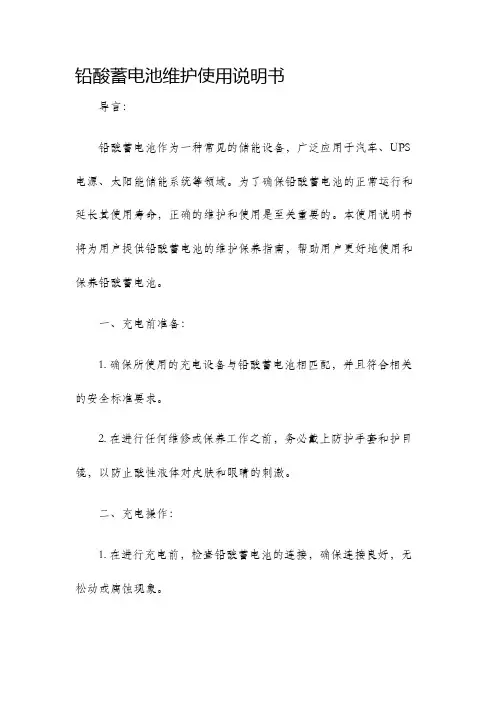
铅酸蓄电池维护使用说明书导言:铅酸蓄电池作为一种常见的储能设备,广泛应用于汽车、UPS 电源、太阳能储能系统等领域。
为了确保铅酸蓄电池的正常运行和延长其使用寿命,正确的维护和使用是至关重要的。
本使用说明书将为用户提供铅酸蓄电池的维护保养指南,帮助用户更好地使用和保养铅酸蓄电池。
一、充电前准备:1. 确保所使用的充电设备与铅酸蓄电池相匹配,并且符合相关的安全标准要求。
2. 在进行任何维修或保养工作之前,务必戴上防护手套和护目镜,以防止酸性液体对皮肤和眼睛的刺激。
二、充电操作:1. 在进行充电前,检查铅酸蓄电池的连接,确保连接良好,无松动或腐蚀现象。
2. 在充电过程中,严禁将正负极短路,以免引发火灾或电池损坏。
3. 维持适当的充电电流和电压,不要过度充电或过快充电,以免对电池产生不良影响。
4. 当充电完成后,及时关闭充电设备,并拔下电源线。
三、放电操作:1. 在使用铅酸蓄电池时,避免过度放电,以免损坏电池或降低电池的使用寿命。
2. 当电池储存能量耗尽时,应及时停止使用,并对电池进行充电,以保证其正常运行。
3. 严禁将铅酸蓄电池处于完全放电的状态下长时间放置不用,建议每三个月对电池进行一次补电。
四、维护保养:1. 定期检查铅酸蓄电池的外观,如有破裂、变形或泄漏现象,应立即更换电池。
2. 清洁电池表面的灰尘和污垢,可以使用湿布擦拭,但严禁使用化学溶剂或腐蚀性物质。
3. 定期检查铅酸蓄电池的电解液水平,确保其位于指示线之间。
4. 若电解液水平低于指示线,只能使用蒸馏水或去离子水进行补充,严禁使用自来水或含有杂质的水进行补充。
5. 注意保持电池的通风环境,不要将电池放置在密闭的空间或高温环境中。
五、安全注意事项:1. 铅酸蓄电池具有腐蚀性,请避免将酸液接触到皮肤、眼睛或衣物上,如不慎溅到,请用大量清水冲洗并及时就医。
2. 避免将铅酸蓄电池暴露在火源或高温环境中,以免引起火灾或电池爆炸。
3. 存放铅酸蓄电池时,应远离儿童和宠物,防止误食引发危险。
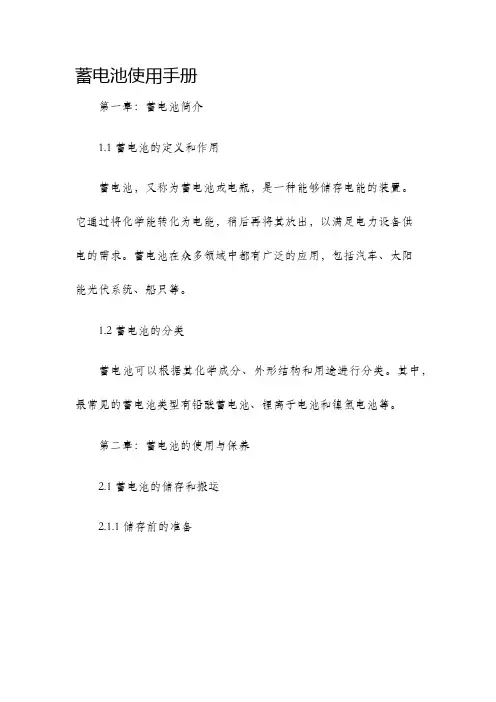
蓄电池使用手册
第一章:蓄电池简介
1.1 蓄电池的定义和作用
蓄电池,又称为蓄电池或电瓶,是一种能够储存电能的装置。
它通过将化学能转化为电能,稍后再将其放出,以满足电力设备供
电的需求。
蓄电池在众多领域中都有广泛的应用,包括汽车、太阳
能光伏系统、船只等。
1.2 蓄电池的分类
蓄电池可以根据其化学成分、外形结构和用途进行分类。
其中,最常见的蓄电池类型有铅酸蓄电池、锂离子电池和镍氢电池等。
第二章:蓄电池的使用与保养
2.1 蓄电池的储存和搬运
2.1.1 储存前的准备
在长时间不使用蓄电池之前,应该将其充满电,并存放在干燥、通风良好的环境中。
此外,还应定期检查蓄电池的接线,确保其正
常工作。
2.1.2 蓄电池的搬运
在搬运蓄电池时,应遵循以下注意事项:
- 使用合适的工具和装备,以确保安全搬运。
- 避免将蓄电池摔落或碰撞,以防损坏。
- 尽量避免磁性物品和金属物品接触蓄电池。
2.2 蓄电池的安装和连接
2.2.1 安装前的准备
在安装蓄电池之前,应确保以下几点:
- 确定蓄电池的安装位置和方向,以便于接线和维护。
- 清洁和检查安装位置,确保无积尘和腐蚀物。
2.2.2 连接蓄电池
在连接蓄电池时,应按照以下步骤进行操作:。
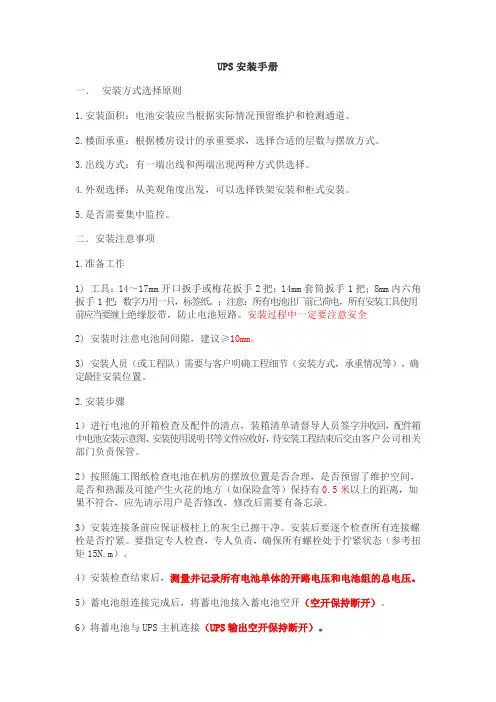
UPS安装手册一.安装方式选择原则1.安装面积:电池安装应当根据实际情况预留维护和检测通道。
2.楼面承重:根据楼房设计的承重要求,选择合适的层数与摆放方式。
3.出线方式:有一端出线和两端出现两种方式供选择。
4.外观选择:从美观角度出发,可以选择铁架安装和柜式安装。
5.是否需要集中监控。
二.安装注意事项1.准备工作1) 工具:14~17mm开口扳手或梅花扳手2把;14mm套筒扳手1把;8mm内六角扳手1把;数字万用一只,标签纸。
;注意:所有电池出厂前已荷电,所有安装工具使用前应当要缠上绝缘胶带,防止电池短路。
安装过程中一定要注意安全2) 安装时注意电池间间隙,建议≥10mm。
3) 安装人员(或工程队)需要与客户明确工程细节(安装方式,承重情况等),确定最佳安装位置。
2.安装步骤1)进行电池的开箱检查及配件的清点,装箱清单请督导人员签字并收回,配件箱中电池安装示意图、安装使用说明书等文件应收好,待安装工程结束后交由客户公司相关部门负责保管。
2)按照施工图纸检查电池在机房的摆放位置是否合理,是否预留了维护空间,是否和热源及可能产生火花的地方(如保险盒等)保持有0.5米以上的距离,如果不符合,应先请示用户是否修改,修改后需要有备忘录。
3)安装连接条前应保证极柱上的灰尘已擦干净。
安装后要逐个检查所有连接螺栓是否拧紧。
要指定专人检查,专人负责,确保所有螺栓处于拧紧状态(参考扭矩15N.m)。
4)安装检查结束后,测量并记录所有电池单体的开路电压和电池组的总电压。
5)蓄电池组连接完成后,将蓄电池接入蓄电池空开(空开保持断开)。
6)将蓄电池与UPS主机连接(UPS输出空开保持断开)。
7)将UPS主机接入市电输入空开(空开保持断开)。
9)安装、调试结束后,按照要求填写相关的表格,检查电池情况并记录,同时再检查各个连接螺栓有无拧紧,确保电池防震、防滑及电池间连接等方面的可靠性。
测量每个单体电池的浮充电压并记录,并测量每个电连接接触点的温升(1小时率放电1小时不超过45℃),请客户进行签字认可。
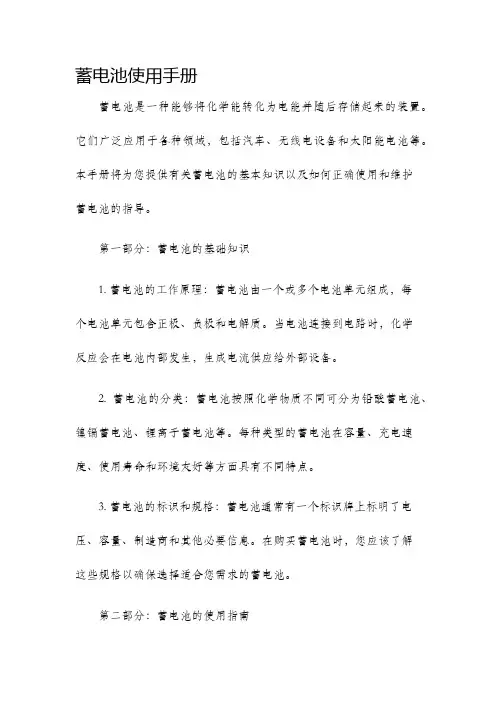
蓄电池使用手册蓄电池是一种能够将化学能转化为电能并随后存储起来的装置。
它们广泛应用于各种领域,包括汽车、无线电设备和太阳能电池等。
本手册将为您提供有关蓄电池的基本知识以及如何正确使用和维护蓄电池的指导。
第一部分:蓄电池的基础知识1. 蓄电池的工作原理:蓄电池由一个或多个电池单元组成,每个电池单元包含正极、负极和电解质。
当电池连接到电路时,化学反应会在电池内部发生,生成电流供应给外部设备。
2. 蓄电池的分类:蓄电池按照化学物质不同可分为铅酸蓄电池、镍镉蓄电池、锂离子蓄电池等。
每种类型的蓄电池在容量、充电速度、使用寿命和环境友好等方面具有不同特点。
3. 蓄电池的标识和规格:蓄电池通常有一个标识牌上标明了电压、容量、制造商和其他必要信息。
在购买蓄电池时,您应该了解这些规格以确保选择适合您需求的蓄电池。
第二部分:蓄电池的使用指南1. 蓄电池的安全使用:在使用蓄电池时应遵循安全操作规程。
确保正确连接电极,避免短路和过度放电。
使用防护手套和眼镜以防止受伤,尽量避免热源和火花附近使用蓄电池。
2. 充电和使用蓄电池:在使用之前,确保蓄电池已经充分充电。
使用电池时需定期检查电压和容量,以确保电池正常工作。
避免将电池长时间放置在高温或极寒的环境中。
3. 蓄电池的维护:定期清洁电池外壳,避免蓄电池接触水分或腐蚀物。
防止电池过度放电或过度充电,使用专门的充电设备和充电器。
遵守制造商的建议,定期检查和更换蓄电池。
第三部分:常见问题解答1. 蓄电池的寿命是多久?蓄电池的寿命取决于制造商的规格和使用环境。
通常情况下,蓄电池的使用寿命为2到5年。
2. 如何处理蓄电池的废物?蓄电池属于特殊垃圾,不能随意丢弃。
请咨询当地的废物管理机构,了解如何正确处理蓄电池并参与电池回收计划。
3. 为什么充电时间很长?充电时间取决于电池的容量和充电器的功率。
较大容量的电池和较低功率的充电器需要更长时间来充电。
总结:蓄电池是现代生活不可或缺的能源存储装置之一。
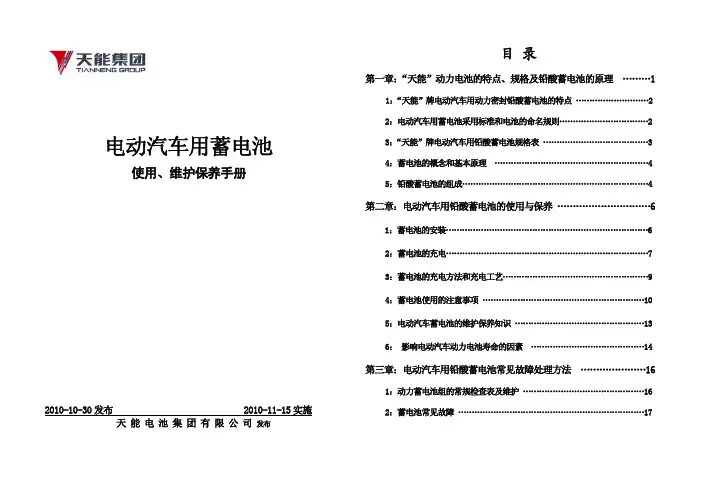
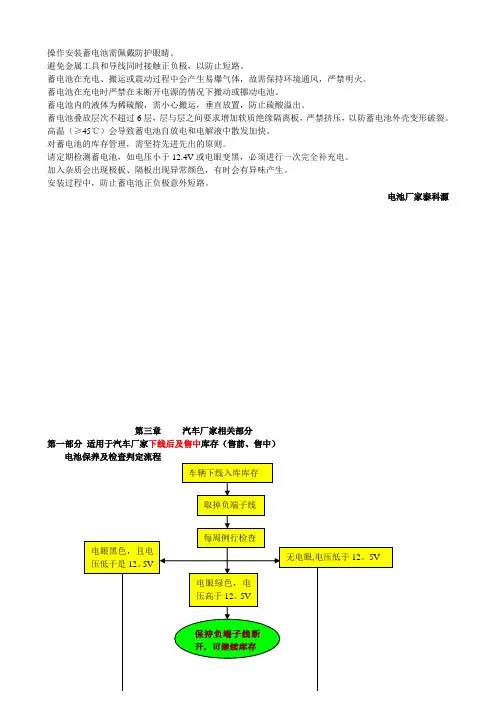
操作安装蓄电池需佩戴防护眼睛。
避免金属工具和导线同时接触正负极,以防止短路。
蓄电池在充电、搬运或震动过程中会产生易爆气体,故需保持环境通风,严禁明火。
蓄电池在充电时严禁在未断开电源的情况下搬动或挪动电池。
蓄电池内的液体为稀硫酸,需小心搬运,垂直放置,防止硫酸溢出。
蓄电池叠放层次不超过6层,层与层之间要求增加软质绝缘隔离板,严禁挤压,以防蓄电池外壳变形破裂。
高温(≥45℃)会导致蓄电池自放电和电解液中散发加快。
对蓄电池的库存管理,需坚持先进先出的原则。
请定期检测蓄电池,如电压小于12.4V或电眼变黑,必须进行一次完全补充电。
加入杂质会出现极板、隔板出现异常颜色,有时会有异味产生。
安装过程中,防止蓄电池正负极意外短路。
电池厂家泰科源第三章汽车厂家相关部分第一部分适用于汽车厂家下线后及售中库存(售前、售中)第二部分:售后车辆电池检查及分析流程按本手册第四章售后电池检测流程及判断和第六章售后车辆电池检查分析。
第四章售后电池检测流程及判断(适用于电池经销商,汽车制造厂家的售后车辆)二检测方法负载检测;在室温下,用放电叉以1/2起动电流(BIC,参考电池顶盖标签)放电15秒。
漏电测试:关闭发电机和车辆上所有用电器。
在保证回路无断点的条件下,将一只带有毫安刻度的电流计(可使用万用表测量)串联入电路,接在蓄电池的负极上,将量程调为最大。
观察表盘,调整量程直到获得精确的数值为止。
搭桥起动:1、用一跟搭桥连线连接两蓄电池的正极。
2、用另一跟搭桥连线连接良好蓄电池的负极和起动困难车辆的发电机上远离蓄电池和化油器的适当部位。
3、确认搭桥连线不会影响车辆风扇/皮带和其他零件的运动。
4、发动车辆后按照上述相反的顺序撤除搭桥连线。
第五章蓄电池充电注意事项1请在蓄电池充电前严格按照第六式退回蓄电池检测流程对蓄电池作出判断,符合充电条件后再开始以下充电程序。
2不可对外壳破裂/电眼呈白色或电解液已凝固的蓄电池充电。
3蓄电池的充电必须在通风良好的环境中进行。
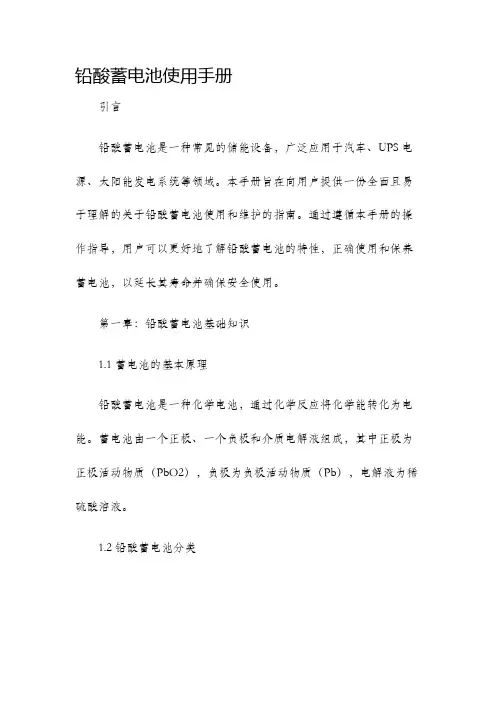
铅酸蓄电池使用手册引言铅酸蓄电池是一种常见的储能设备,广泛应用于汽车、UPS电源、太阳能发电系统等领域。
本手册旨在向用户提供一份全面且易于理解的关于铅酸蓄电池使用和维护的指南。
通过遵循本手册的操作指导,用户可以更好地了解铅酸蓄电池的特性,正确使用和保养蓄电池,以延长其寿命并确保安全使用。
第一章:铅酸蓄电池基础知识1.1 蓄电池的基本原理铅酸蓄电池是一种化学电池,通过化学反应将化学能转化为电能。
蓄电池由一个正极、一个负极和介质电解液组成,其中正极为正极活动物质(PbO2),负极为负极活动物质(Pb),电解液为稀硫酸溶液。
1.2 铅酸蓄电池分类根据用途和结构不同,铅酸蓄电池可以分为起动电池、动力电池和太阳能电池等。
起动电池用于汽车起动,动力电池用于电动车或升降机,太阳能电池用于储存太阳能。
1.3 蓄电池的主要特性了解蓄电池的主要特性对正确使用和维护至关重要。
蓄电池的主要特性包括额定容量、电压、内阻、循环寿命、自放电率等。
第二章:蓄电池的安全使用2.1 充电前的准备在充电之前,务必检查蓄电池的外观是否有明显损坏,并确保充电设备的安全性能和充电参数与蓄电池匹配。
2.2 充电方法和注意事项根据蓄电池的充电类型(常流充电或浮充充电),选择合适的充电方式。
在充电过程中,注意避免过度充电和过度放电,以免损害蓄电池性能。
2.3 蓄电池的正确连接和断开正确连接蓄电池可以避免电火花和其他意外事故的发生。
在连接和断开蓄电池时,先断开负极,再断开正极,并加上绝缘套管以保护连接部位。
第三章:蓄电池的日常维护3.1 充电状态的监测定期检测蓄电池的充电状态,避免过度放电和过度充电,以延长蓄电池的使用寿命。
3.2 温度和通风控制蓄电池在运行过程中会产生一定的热量,应确保蓄电池的工作温度在适当范围内。
并保持通风良好,防止蓄电池过热。
3.3 清洁和防护措施定期清洁蓄电池的端子和外壳,防止积灰和腐蚀。
使用绝缘套管和防护罩来避免蓄电池的短路和外力损坏。
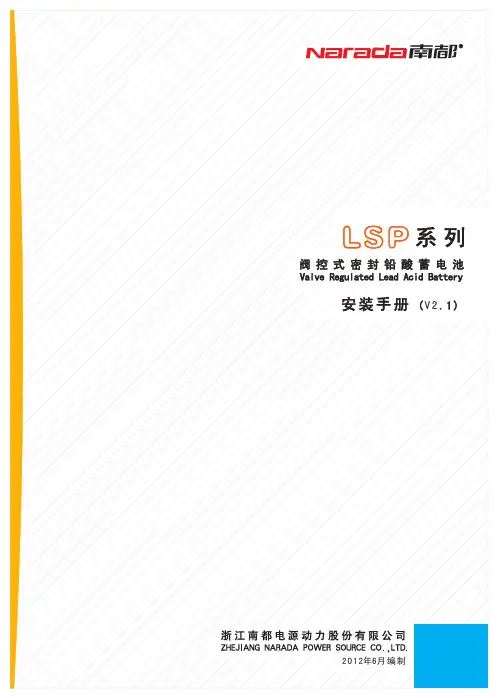
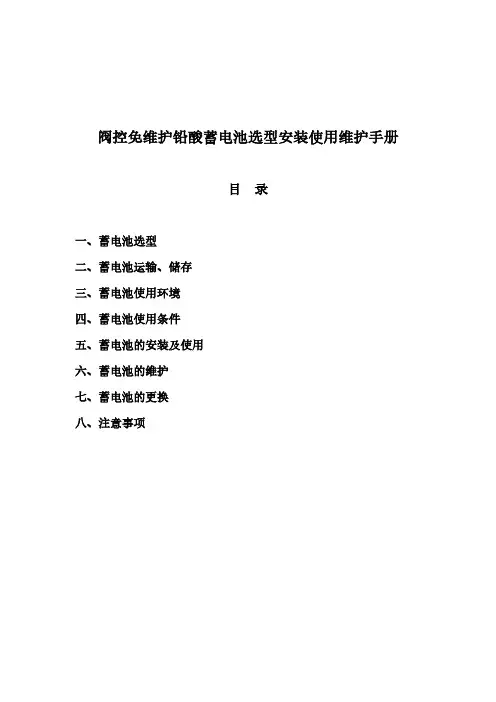
阀控免维护铅酸蓄电池选型安装使用维护手册目录一、蓄电池选型二、蓄电池运输、储存三、蓄电池使用环境四、蓄电池使用条件五、蓄电池的安装及使用六、蓄电池的维护七、蓄电池的更换八、注意事项一、蓄电池选型✧ 电池经常充放电循环使用,建议选用适合UPS设备的大容量阀控铅酸免维护电池;✧电池如果需短时间大电流放电,建议选用高功率系列;✧考虑到电池老化,选型时建议给予不低于20%的余量。
✧电池使用过程中容量会有所升高,因此初期性能达到额定容量的95%可认为容量合格。
✧选型可分为按电流选型及按功率选型两种:1、按容量、电流选型(一般需知道工作电流、工作时间、终止电压等)例如:某48V直流备用电源系统,平均工作电流16A,停电时需要蓄电池组支持5小时,系统低压报警电压42.0V,客户要求使用12V电池,计算选型。
(1)计算每单格终止电压:42.0 volts/24 cells=1.75Vpc(2)由此可得出单格性能要求为恒流16A到1.75 Vpc(3)查阅电池放电性能数据表,得到12V-100AH在5h放电到 1.75 Vpc电流是17.6A >16A,满足要求且有10%的余量。
(4)结论:选用4只12V-100AH电池串联。
2、按功率选型(需知道系统电压、功率要求、工作时间、终止电压等)UPS选用电池容量计算公式:UPS功率×功率因数/转换效率=电池的总功率例如:某UPS功率是20KV A,直流电压为408V,功率因数为0.8,转换效率是0.85,停电时需要蓄电池组支持2小时,系统低压报警电压357V,客户要求使用12V电池,计算选型。
(1)计算电池总功率需求:20KV A×0.8/0.9=17777.8W(2)平均到每个单格:17777.8W/204 cells=87.1W/cell(3)每单格终止电压:357 volts/204 cells=1.75Vpc(4)由此可得出单格性能要求为恒功率92.3W到1.75 Vpc(5)查阅电池放电性能数据表,发现12V-150AH电池在2h放电到1.75 Vpc功率是106W/ cells >87.1W/cell,满足要求且有15%的余量。
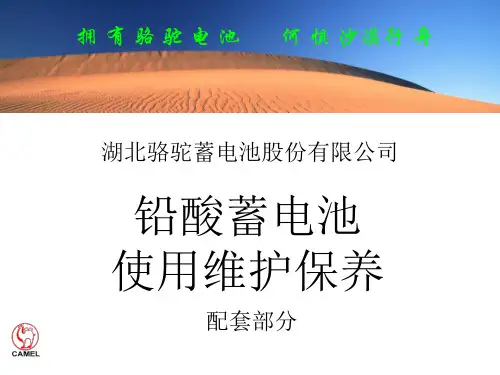
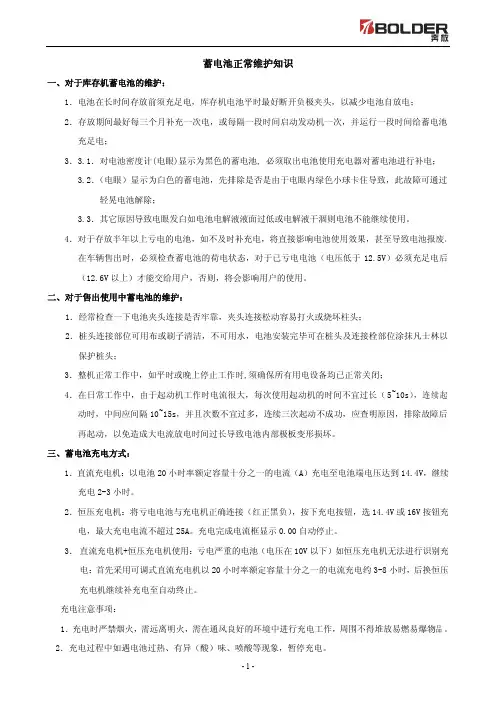
蓄电池正常维护知识一、对于库存机蓄电池的维护:1.电池在长时间存放前须充足电,库存机电池平时最好断开负极夹头,以减少电池自放电;2.存放期间最好每三个月补充一次电,或每隔一段时间启动发动机一次,并运行一段时间给蓄电池充足电;3.3.1.对电池密度计(电眼)显示为黑色的蓄电池,必须取出电池使用充电器对蓄电池进行补电;3.2.(电眼)显示为白色的蓄电池,先排除是否是由于电眼内绿色小球卡住导致,此故障可通过轻晃电池解除;3.3.其它原因导致电眼发白如电池电解液液面过低或电解液干涸则电池不能继续使用。
4.对于存放半年以上亏电的电池,如不及时补充电,将直接影响电池使用效果,甚至导致电池报废。
在车辆售出时,必须检查蓄电池的荷电状态,对于已亏电电池(电压低于12.5V)必须充足电后(12.6V以上)才能交给用户,否则,将会影响用户的使用。
二、对于售出使用中蓄电池的维护:1.经常检查一下电池夹头连接是否牢靠,夹头连接松动容易打火或烧坏柱头;2.桩头连接部位可用布或刷子清洁,不可用水,电池安装完毕可在桩头及连接栓部位涂抹凡士林以保护桩头;3.整机正常工作中,如平时或晚上停止工作时,须确保所有用电设备均已正常关闭;4.在日常工作中,由于起动机工作时电流很大,每次使用起动机的时间不宜过长(5~10s),连续起动时,中间应间隔10~15s,并且次数不宜过多,连续三次起动不成功,应查明原因,排除故障后再起动,以免造成大电流放电时间过长导致电池内部极板变形损坏。
三、蓄电池充电方式:1.直流充电机:以电池20小时率额定容量十分之一的电流(A)充电至电池端电压达到14.4V,继续充电2-3小时。
2.恒压充电机:将亏电电池与充电机正确连接(红正黑负),按下充电按钮,选14.4V或16V按钮充电,最大充电电流不超过25A。
充电完成电流框显示0.00自动停止。
3.直流充电机+恒压充电机使用:亏电严重的电池(电压在10V以下)如恒压充电机无法进行识别充电:首先采用可调式直流充电机以20小时率额定容量十分之一的电流充电约3-8小时,后换恒压充电机继续补充电至自动终止。
蓄电池使用说明书一、产品介绍蓄电池是一种能够存储电能并在需要时释放电能的装置。
它由一系列电化学反应组成,通过化学能转化为电能。
蓄电池常用于备用电源、储能系统、汽车和其他电动设备等领域。
二、安全注意事项1. 请勿将蓄电池直接暴露在高温环境下,以避免损坏电池性能。
2. 请勿将蓄电池投入水中或其他液体中,以免引起电池损坏或引发电击危险。
3. 当使用蓄电池时,请注意防止短路,避免金属物品接触电池两极。
4. 请勿将蓄电池与阳光直接接触,以免损坏电池外壳。
5. 如果电池出现损坏、漏液或发生异常情况,请立即停止使用并联系专业人员进行处理。
三、充电须知1. 在首次使用蓄电池之前,请先仔细阅读说明书,并确保了解正确的充电方式。
2. 使用正确的充电器进行充电,切勿使用不符合规定或低质量的充电器。
3. 在充电时,请确保充电器与电源的连接牢固,避免充电过程中出现意外情况。
4. 充电时请保持通风良好的环境,避免过热或过冷的环境。
5. 在充电过程中,如发现异常情况(如电池过热、充电时间过长等),请立即停止充电,并与厂家联系。
四、使用方法1. 在使用蓄电池之前,请先确保电池已充满电。
2. 将蓄电池正确安装在相应的设备或车辆中,确保极性正确连接。
3. 在正常使用过程中,如发现电池性能下降,电量不足等情况,请及时充电或更换电池。
4. 在存储蓄电池时,请避免长时间不使用导致电量耗尽,应定期检查电池的电量并充电。
5. 在长时间不使用蓄电池时,请将电池储存在干燥、通风的环境中,并定期充电以保持电池性能。
五、维护保养1. 定期清洁蓄电池的外壳,并确保其表面干燥。
2. 如果电池外壳有损坏,应及时更换,并避免继续使用,以免引发安全隐患。
3. 请勿拆卸或改装蓄电池,以免损坏电池性能或引发安全风险。
4. 当电池寿命结束时,请咨询专业人员进行处理,切勿随意丢弃。
六、故障排除1. 当蓄电池无法保持充电或电池寿命显著降低时,请联系专业人员进行检修或更换。
目录(一)使用须知及注意事项 (2)(二)使用前旳准备和检查事项 (2)(三)操作 (3)(四)维护和保养 (4)(五)储存 (5)(六)故障及排除 (5)附录一:充电操作规程 (6)附录2:车型、蓄电池、充电机适配表 (10)电动车蓄电池使用维护阐明(一)使用须知及注意事项1、请仔细阅读使用阐明。
2、只容许专业人员操作蓄电池。
3、在使用和充电过程中:禁烟、严禁明火、暗火或火花接近蓄电池,否则易发生爆炸和火灾危险。
4、操作人员应佩戴好防护眼镜,穿上防护服。
遵守操作规范。
5、在操作过程中,如有酸液溅入眼内或皮肤上,必须立即用冷水冲洗,并寻找医生进一步解决。
衣服上沾上酸液也请用水冲洗。
6、防爆、防火和防短路!电池旳金属件上始终带电!7、电解液具有强烈旳腐蚀性!8、请勿翻转蓄电池,使用准许旳吊装运送机械。
吊钩不得损坏电池或连接电缆。
(二)使用前旳准备和检查事项1、收货当货品送达时,收货人员必须及时验收、检查:A、有无任何漏电解液旳迹象,或电池有无遭受撞击旳变形及损毁。
B、电池壳面与否凹陷、破裂,连接线缆有否损毁。
C、电瓶塞、连接线缆及其他配件与否齐全。
D、对电池状况如有疑问,请做好记录并告知供应商。
2、初次使用——已灌注电解液及充电电池A、检查电解液液位与否在电池瓶塞盖可见液位。
对初次使用旳新蓄电池前十次旳充放电,毋须加补充水。
B、检查确认充电机与电池与否合适,如有需要与车辆制造商技术工程人员沟通确认。
C、按有关使用程序,连接电池与充电机。
注意:正负极位与否对旳!D、按有关使用守则对电池进行充电。
E、在初始有效期间,留意电池状况,避免深度放电(超过70%容量)。
车辆装有电量表,可清晰批示。
3、初次使用——未灌注电解液旳未充电电池A、所有未灌注电解液没有启用旳新蓄电池必须寄存于干燥、通风、荫凉旳储存室。
B、未充电旳蓄电池投入使用,务必做好蓄电池旳初充电工作,初充电对蓄电池旳性能质量和寿命起着决定性旳作用!C、初充电操作环节(1)、灌液移除蓄电池注液孔塞,灌注电解液至液位盖覆电池极板15mm~20mm。
Installation, Operationand Maintenance Manual Visit us at The maximum storage times before a refresh charge is required andrecommended open circuit voltage audit intervals are:HandlingPowerSafe ® SBS XL blocs and cells are supplied in a charged condition and are capable of extremely high short circuit currents. Take care to avoid short- -circuiting terminals of opposite polarity.ImportantPlease read this manual immediately on receipt of the battery before unpacking and installing. Failure to comply with these instructions will render any warranties null and void.Care for your safety2Keep flames awayIn case of accidental overcharge a flammable gas can leak off the safety vent.Discharge any possible static electricity from clothes by touching an earth connected part.T oolsUse tools with insulated handles.Do not place or drop metal objects on the battery.Remove rings, wristwatch and articles of clothing with metal parts that may come into contact with the batteryterminals.Shield eyesReadinstructionsDangerRecycle scrap batteries. Contains lead.Clean all acid splash in eyes or on skin with plenty of clean water. Then seek medical help. Acid on clothing is to be washed with water.Warning: Risk of fire, explosion, or burns. Do not disassemble, heat above 60°C (140°F), or incinerate. Metallic parts under voltage are present on the battery, avoid short circuit. Do not place tools oritems on top of the battery.+10 / +504812+15 / +593412+20 / +682412+25 / +77176+30 / +86126+35 / +958.53+40 / +104631. ReceivingUpon the receipt of the shipment, check the contents for damage and against the packing slip. Immediately inform EnerSys of any damaged or missing items. EnerSys ® is not responsible for shipment damage or shortages that the receiver does not report to the carrier.2. Storage2.1. Storage Conditions and TimeIf a battery cannot be immediately installed it should be stored in a clean, cool and dry area. During storage blocs and cells lose capacity through self-discharge. High temperatures increase the rate of self-discharge and reduce the storage life.The chart below shows the relationship between open-circuit voltage (OCV) and storage time at various temperatures.Blocs/cells must be given a refresh charge when the OCV approaches the equivalent of 2.10 Volts per cell or when the maximum storage timeis reached, whichever occurs first.California Proposition 65 Warning – Battery posts, terminals, and related accessories contain lead and lead compounds, chemicals known to the State of California to cause cancer and reproductive harm. Wash hands after handling.2.2. Refresh ChargeCharge at a constant voltage equivalent to 2.29 – 2.40Vpc with a minimum 0.1C 10 Amps available for a period of 24 hours.2.3. Commissioning ChargeBefore commencing operation, the battery must be given a commissioning charge. The batteries should be charged using constant voltage with a minimum charge current of 0.1C the battery. Either of the following methods can be used:• Charge for 96 hours at the recommended float voltage of 2.29Vpc at 20°C / 68°F or• Charge for 24 hours at the recommended boost charge voltage of 2.40Vpc at 20°C / 68°F The battery will then be switched over to float charging, maintaining the battery under floating voltage for 24 hours before any discharge test.3. Battery LocationThe battery compartment/room must have adequate ventilation to limithydrogen accumulation. Batteries must be installed in accordance with the IEC 62485-2 standard and any other local/national laws and regulations.4. InstallationPowerSafe SBS XL batteries are designed for stable grid float applications (non-cyclic applications). 12V blocs can be installed on their baseor horizontally on their longest side whilst 2V cells can be mountedin any orientation except inverted.With regards to the installation of 2V cells in horizontal orientationspecifically, the instructions below must be complied with:• Do not use terminal posts to lift or handle cells.• Do not install the cells in such a way that the box-lid seal is resting on a runner.• Always ensure that the arrow on the lid of each unit is pointing in vertical orientation.Place the insulating covers in position immediately after tightening the fasteners.+10 / +504812+15 / +593412+20 / +682412+25 / +77176+30 / +96126+35 / +958.53+40 / +1046335. OperationOptimum performance and service life are achieved at a temperature of 20/25°C (68/77°F). The operating temperature range is as follows:• SBS XL 2V cells: -40°C to +50°C (-40°F to +122°F)• SBS XL 12V blocs: -40°C to +65°C (-40°F to +149°F).5.1. Standby / Float OperationConstant voltage chargers are recommended. The charging voltage should be set at the equivalent of 2.29Vpc at 20°C (68°F) or 2.275Vpc at 25°C (77°F). The recommended float voltage temperature compensation is:• +3mV per cell per °C below 20°C • –3mV per cell per °C above 20°CThe minimum charging voltage, at any temperature, is 2.21Vpc.5.2. Charging CurrentDue to the very low internal resistance PowerSafe ® SBS XL batteries will accept unlimited current during recharge but for cost and practical purposes in float applications where recharge time to repeat duty is not critical, the rectifier current can be limited to the load plus 0.1C 10 Amps.5.3. DischargingBatteries must not be left in a discharged condition after supplying the load but must immediately return to recharge mode.Failure to observe these conditions may result in greatly reduced service life.Accidental deep dischargingFor optimum operation the minimum voltage of the system should be related to the duty as follows:In order to protect the battery it is advisable to have system monitoring and low voltage cut-out.Deep discharge will produce a premature deterioration of the battery and a noticeable reduction in the life expectancy of the battery.Effect of temperatureThe temperature has an effect on the battery capacity. With increased operating temperature the capacity increases; likewise with decreasing temperature the capacity decreases.6. MaintenanceIn practice, the user usually specifies the maintenance schedule based on site criticality, location and manpower. However, the following may be used as a suggested maintenance schedule. Typically, the maintenance frequency for standard VRLA batteries is scheduled every 6 months.However, as a result of the increased design life inherent with the SBS XL range this interval frequency can be extended to deliver additional Total Cost of Ownership (TCO) benefit, particularly during the early period ofservice. As the battery approaches 80% of the intended service it would be beneficial to increase the frequency of maintenance.Keep a logbook to record values, power outages, discharge tests, etc.• Measure the battery string voltage. If necessary, adjust the float voltage to the correct value.• Measure individual bloc / cell voltages. After six months of operation, blocs/cells should be within 5% of the voltage value during float charge, as specified in chapter 5.1.• Check the ambient temperature in the immediate environment.• Inspect for contamination by dust, loose or corroded connections.If necessary, isolate the string/bloc/cell and clean with a damp soft cloth.Warning: Do NOT use any type of oil, solvent, detergent, petroleum-based solvent or ammonia solution to clean the battery containers or lids. These materials will cause permanent damage to the battery container and lid and will invalidate the warranty.State of health monitoringTypically a load test can be carried out once a year.Capacity discharge testing is considered as the only true guide to state of health but can be complimented by the use of Ohmic measurement trending e.g. Conductance.• A discharge test should only be carried out on a fully charged battery.• For a new battery a discharge test should only be carried out after the commissioning charge is completed as specified in section 2.3.Ensure the battery is fully recharged before capacity testing and always complete a full discharge test (partial discharges can lead to false assessment of state of health).Best practice is to define the discharge test based on the application in terms of the load, autonomy or what is practical. The load and end of discharge voltage should be based on published performance literature. Depending on the operating temperature a compensation correction factor may be required.Log individual bloc/cell voltage throughout the duration of the test at regular intervals.Following the capacity test the battery should be fully recharged in accordance with instructions in section 5.Ohmic measurementsThe correct way to use Ohmic readings is as a trending tool over time to detect potentially weak or troublesome blocs/cells in a VRLA battery string in float in service. When the string is first installed and stabilized, a set of “initial” Ohmic readings should be taken. Since at this time there may still be some significant variations bloc to bloc/cell to cell in state of charge, separator acid content, recombination efficiency, etc. it is not unusual for these initial readings to be typically ± 50% of the mean. If some blocs/cells exceed this, it would be judicious to equalize charge the string and do a capacity test.After the string has been in service for about 6 months, the previousmentioned variations tend to normalise. At this point another set of Ohmic readings should be taken and used as the “baseline” readings. At this point, the blocs/cells should be typically within ± 30% of the average.These individual “baseline” readings will serve as a reference for trending purposes for comparison to readings taken later in the battery’s life.On a yearly basis, Ohmic readings should be taken, recorded and compared to the baseline readings. If a bloc/cell or battery Ohmic reading varies more than 50% from the baseline value, the battery should be further evaluated to determine the cause. A performance or capacity test should be part of this evaluation.7. DisposalPowerSafe SBS XL batteries are recyclable. Scrap batteries must be packaged and transported in accordance with prevailing transportation rules and regulations.Scrap batteries must be disposed of in compliance with local and nationallaws by a licensed or certified lead acid battery recycler.1h ≤ t ≤ 5h 1.70V 5h ≤ t ≤ 8h 1.75V 8h ≤ t ≤ 20h1.80VM -P S -S B S X L -0421。